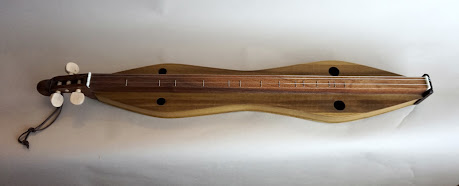dulcimoredan self
The Traditional Appalachian Dulcimore Maker nestled in the heart of
the Cumberland Gap. Indigenous woods, staple frets and hand rubbed
finishes for that high silvery sound of yesteryear! I am also an
amateur historian and curator preserving the craft. I’ve been tinkering
with this craft for some twelve year or so and have completed well over 250
pieces. I share recordings and have over 2,000,000 listens on Soundcloud!
The ‘dulcimore’ is a unique survival of antique musical instruments, and needs explanation. It is oblong, about thirty-four inches in length, with a width at its greatest of about six inches, becoming smaller at each end. Three strings reach from tip to tip, the first and second ones tuned to the same pitch, and the third one forms the bass string. Two octaves and a quarter are marked out upon the three-quarters of an inch piece of wood that supports, and is just under the strings on the top of the instrument. The Mountaineer “toilers pickin'” it by means of a quill, with which he strikes the three strings at the same time with his right hand, over the gap at the larger end, at the same time using in his left hand a small reed with which he produces the air, or his “single string variations.” The music of the dulcimore resembles that of the Scottish bag pipe, in that it is weird and strange. Under its spell one finds himself mysteriously holding communion with the gossamer-like manes of the long-departed souls of the palace of Lady Rowena Trevanion, of Tremaine. The dulcimore is rapidly becoming a thing of the past, because the Mountaineers are becoming ashamed’ of the musical instrument that stands, with many other things, on the dividing line between two civilizations. Only a few of them are extant. Within a few more years and this strange old relic of by-gone days will pass…..
The Kentucky Highlanders from a Native Mountaineer’s Viewpoint
by Josiah Henry Combs
J. L. Richardson and Co.
Lexington, KY 1913
The ‘dulcimore,’ better known to dictionary folk as dulcimer, is an instrument indigenous to this region. (Appalachia) It resembles a violin with greatly narrowed and elongated body and shortened neck; it is made of walnut or maple wood and is strung with three strings plucked by a crow-quill held in the right hand. The melody is produced by the pressure of a bit of reed in the left hand upon the proper fret in the finger-board lying underneath the strings, as in a mandolin. Of the three strings, only the first is thus touched, and with the left hand. The other two, tuned an octave apart, are always open, and keep up a bourdonnement not unlike that of the bagpipe, to the thread of melody played on the third string. Simple one-part tunes prevail, rarely reaching an octave in compass.
British Ballads in the Cumberland Mountains
by HUBERT G. SHEARIN, M.A., Ph.D. December 15, 1911
Professor of English in Transylvania University
Danny L. Cox
aka: Dulcimore Dan
319 Mallory Drive
New Tazewell, TN
email me @
dulcimoredan@gmail.com
Prices start at just $425.






Comments
Post a Comment